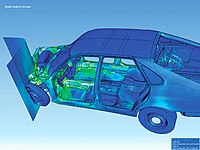
Photo from wikipedia
Abstract Most wells are not produced under a single production condition in practice. Because the complexity caused by production condition changes is compounded, few studies have focused on wells under… Click to show full abstract
Abstract Most wells are not produced under a single production condition in practice. Because the complexity caused by production condition changes is compounded, few studies have focused on wells under variable inner boundary conditions. This work proposes a semi-analytical model for multiple-fracture horizontal (MFH) gas wells under a two-stage inner boundary condition by applying source functions. The two-stage condition in this work represents the type of inner boundary condition change from the Dirichlet boundary condition to the Neumann boundary condition during production. An intermediate function is established to eliminate the effect whereby the initial pressure is not uniform. Pseudofunctions and Laplace transform are utilized to solve the model's mathematical problem. In addition, the accuracy of this model is fully verified by numerical examples. Finally, analysis of the characteristics of an MFH gas well under the two-stage condition is conducted. The results suggest that a low limiting pressure will lead to higher cumulative production. The initial rate mainly affects the production time and does not affect the final cumulative production. The initial rate should be adjusted based on the actual demand downstream and known fracture parameters, including the fracture half-length, fracture conductivity and fracture number. The limiting bottomhole pressure, initial rate and fracture parameters affect the formulation and optimization of the rational production allocation and production system for MFH wells. Moreover, combined with a variable-rate/pressure solution, this two-stage model can be expanded for more multistage production conditions. This work provides an approximation method for solving the nonlinear diffusivity gas equation under variable inner boundary conditions.
Journal Title: International Journal of Heat and Mass Transfer
Year Published: 2020
Link to full text (if available)
Share on Social Media: Sign Up to like & get
recommendations!